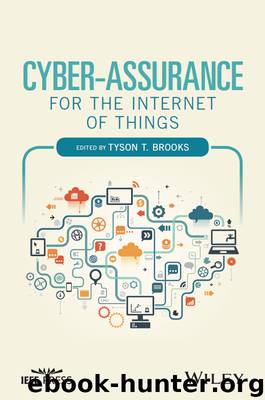Cyber-Assurance for the Internet of Things by Tyson T. Brooks

Author:Tyson T. Brooks
Language: eng
Format: epub
ISBN: 9781119193876
Publisher: Wiley
Published: 2016-12-14T00:00:00+00:00
Figure 7.2 An IoT-enabled home automation system. Reproduced with permission of IEEE.
The controller and the field devices (i.e., smart devices) share raw operational data, raw informational data, instructions, or status information. These instructions can be manipulator information or operational parameters or settings, such as desired temperature, efficiency modes, or control and feedback gain parameters. These devices can be characterized by communicating though IP protocols for constrained devices.4 They generally utilize resilient physical layer protocols5 at lower layers and mesh networking at higher layers. The controller is connected to the user's local area network which is in turn connected to the Internet. It is possible that the local area network and the field area network are physically unified if all devices communicate through similar physical layer protocols; however, the real-time nature of some automation systems will require specialized protocols that are resilient to noise and network congestion (Gomez & Paradells 2010).
As illustrated in Figure 7.3, depending on the application, the system provider is now an integral part of the architecture and can have the following roles:
Provides ubiquitousness to the user by enabling him to have complete control of the system from anywhere, given that the user has access to the Internet;
Updates different control system parameters depending on user request or on the request of automated supervisory functions programmed by the user or set by the service provider through analyzing historical data;
Sends alarms to the user or “third-party” service providers;
Logs operational data that is used for advanced functions, such as learning user's energy utilization for its integration with the smart grid;
Provides enhanced functions to the user;
Assists in firmware and software updates, provides applications, and many others.
Download
This site does not store any files on its server. We only index and link to content provided by other sites. Please contact the content providers to delete copyright contents if any and email us, we'll remove relevant links or contents immediately.
Effective Threat Investigation for SOC Analysts by Yahia Mostafa;(7193)
Practical Memory Forensics by Svetlana Ostrovskaya & Oleg Skulkin(6882)
Machine Learning Security Principles by John Paul Mueller(6861)
Attacking and Exploiting Modern Web Applications by Simone Onofri & Donato Onofri(6514)
Operationalizing Threat Intelligence by Kyle Wilhoit & Joseph Opacki(6492)
Solidity Programming Essentials by Ritesh Modi(4395)
Microsoft 365 Security, Compliance, and Identity Administration by Peter Rising(3994)
Operationalizing Threat Intelligence by Joseph Opacki Kyle Wilhoit(3743)
Learn Computer Forensics - Second Edition by William Oettinger(3491)
Future Crimes by Marc Goodman(3459)
Blockchain Basics by Daniel Drescher(3429)
Mastering Azure Security by Mustafa Toroman and Tom Janetscheck(3427)
Mastering Python for Networking and Security by José Manuel Ortega(3420)
Building a Next-Gen SOC with IBM QRadar: Accelerate your security operations and detect cyber threats effectively by Ashish M Kothekar(3355)
Incident Response with Threat Intelligence by Roberto Martínez(3214)
The Code Book by Simon Singh(3022)
Mastering Bitcoin: Programming the Open Blockchain by Andreas M. Antonopoulos(2951)
Mobile App Reverse Engineering by Abhinav Mishra(2930)
From CIA to APT: An Introduction to Cyber Security by Edward G. Amoroso & Matthew E. Amoroso(2832)
